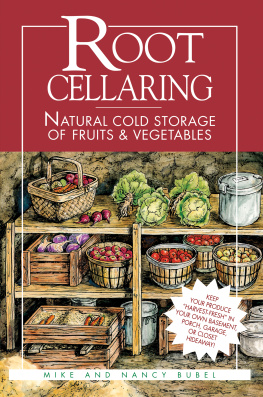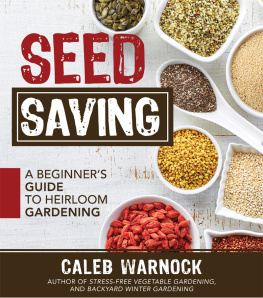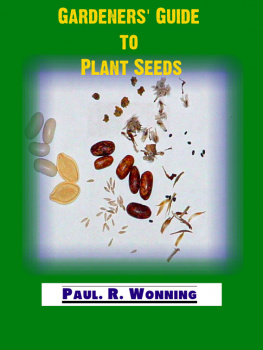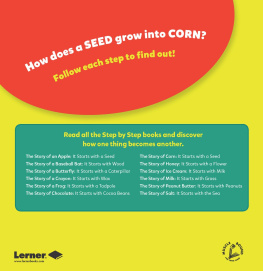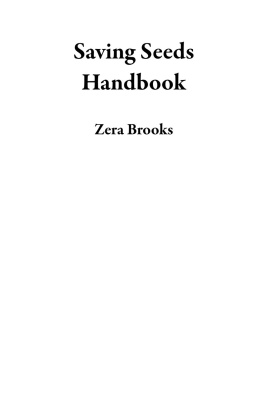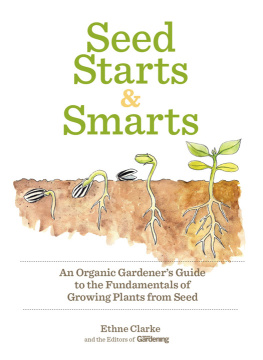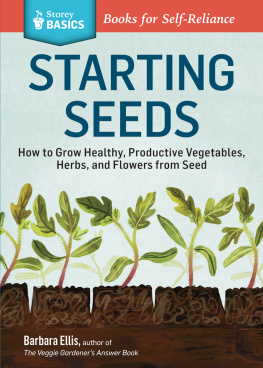
FOR MY PARENTS,MILTON AND GRACE HANGEN WILKES,AND FOR OUR CHILDREN AND THEIR FAMILIES:MARY GRACE, ANTHONY, AND NICHOLAS; GREG, TISH, AND ANSEL.
Mention of specific companies, organizations, or authorities in this book does not imply endorsement by the author or publisher, nor does mention of specific companies, organizations, or authorities imply that they endorse this book, its author, or the publisher. Internet addresses and phone numbers given in this book were accurate at the time it went to press.
This book was previously published as The New Seed-Starters Handbook by Rodale in 1988.
Illustrations by Frank Fetz
Photographs by Alison Miksch and Rodale Images
Book design by Joanna Williams
Library of Congress Cataloging-in-Publication Data is on file with the publisher.
ISBN 9781635651041 paperback
ISBN 978-1-63565-105-8 e-book

We inspire health, healing, happiness, and love in the world.
Starting with you.
RodaleBooks.com
RodaleWellness.com

CONTENTS
ACKNOWLEDGMENTS
In referring to our debt to those who have gone before us, a wise man once said, We stand on the shoulders of giants. This is especially true in gardening, where we have been both enlightened by the experiments of learned men and supported by the faithful efforts of obscure dirt gardeners who have saved and selected seed and cared for the soil over the centuries.
In preparing this book, I received generous helpin the form of correspondence and printed matterfrom Dr. R. J. Downs, Phytotron Director at the North Carolina State University at Raleigh; Dr. Robert F. Fletcher, Extension Specialist in Vegetable Crops at Penn State University; Dr. O. A. Lorenz, Chairman, Department of Vegetable Crops, University of California at Davis; Dr. Raymond Sheldrake, Professor of Vegetable Crops at Cornell University; Dr. H. Garrison Wilkes, Botany Department, Boston Harbor Campus of the University of Massachusetts; Dr. Jay S. Koths, Department of Plant Science, University of Connecticut; Dr. Betty Ransom Atwater, Director, Ransom Seed Laboratory, Santa Barbara, California; and Richard Grazzini, Manager of the H. G. German Seed Co., Smethport, Pennsylvania. Dr. H. Garrison Wilkes, Dr. J. F. Harrington, and Dr. James Edward Knott have kindly permitted me to quote from their work.
In addition, Dr. R. Gregory Plimpton of Atlantic and Pacific Research, Inc., has supplied me with much helpful information. Kent Whealy, originator of the Seed Savers Exchange, Forest Shomer, Director of the Abundant Life Seed Foundation, and Lawrence Hills of the Henry Doubleday Research Foundation have answered my inquiries in a spirit of kind cooperation and allowed me to quote from their writings. Articles by Dr. Jeffrey McCormack and Dr. Mark Widrlechner, published in Seed Savers Exchange Handbooks, have been very helpful.
Also, visits to the following growers were especially helpful: Bertha Reppert, Rosemary House, Mechanicsburg, Pennsylvania; Fairman and Kate Jayne, Sandy Mush Herb Nursery, Leicester, North Carolina; Cyrus Hyde, Well-Sweep Herb Farm, Port Murray, New Jersey; Janet Urban, Botanist, Bowmans Hill Wildflower Preserve, Washington Crossing, Pennsylvania; and Bob Hyland, Education Director, Longwood Gardens, Kennett Square, Pennsylvania.
In addition, I learned much from phone conversations with Roger Kline, Extension Associate, Department of Vegetable Crops, Cornell University; Dr. John Gerber, University of Illinois; Dr. Jim Austin, Park Seed Co.; Pam Dwiggins, Research Botanist, National Wildflower Research Center, Austin, Texas; Dr. Arthur O. Tucker, Delaware State College; Greg Edinger, Naturalist at Bowmans State Hill Wildflower Preserve, Washington Crossing, Pennsylvania; Rob Johnston of Johnnys Selected Seeds, Albion, Maine; Dick Meiners of Pinetree Garden Seeds, Gloucester, Maine; Colleen Armstrong of The New Alchemy Institute, East Falmouth, Massachusetts; and Shepherd Ogden of Cooks Garden Seed Company, Londonderry, Vermont.
My editor, Claire Kowalchik, always had the reader in mind. Im ever so grateful for her careful questions and perceptive suggestions, which have helped immeasurably to make The New Seed-Starters Handbook a better book than the original.
Im grateful, too, to my husband and children, who good-naturedly endure my absentmindedness when I am with book. Special thanks to my son, Greg (who now has his own family garden), for his perseverance in typing the whole much-spliced and much-corrected manuscript of the original edition.
INTRODUCTION
Since 1957, when we tried (and failed!) to grow radishes in a window box outside our third-floor apartment in Philadelphia, my husband, Mike, and I have been learning about growing vegetables. We got off to a slow start. I had only vague memories of the Victory Garden my parents grew for a few years in our New England backyard, and an insistent yearning to begin a garden of my own. Mike had grown up on home-raised vegetablesa surprisingly limited variety of them, though, mostly grown from seed his mother had carefully saved from one harvest to the next: cabbage, potatoes, beans, carrots, beets, dill, cucumbers, and sunflowers. Later, during a stay in Germany, he had taken a course in gardening at a free university of sorts. Mike wanted a garden, too.
When we moved into our first house, we bought digging forks and shovels almost before the ink was dry on the deed. We started that first year with tomatoes and beans and many flowers. It took us several years to progress to planting a garden that we could eat from all summer, but by 1970 our vegetable garden was carrying us year round. Today we hardly ever buy a vegetable. Our year-round supply of vegetables is due in large part to starting seeds early indoors and making continuous outdoor plantings of varieties of food chosen for quality and ease of storage.
Along the way, weve learned a lot about how and when to start different vegetables. Trial and error has helped. Older relatives and neighbors have been generous with advice and lore, and we never start a new gardening year without thinking fondly of our different mentors and how much they have given us over the years. Reading about gardens and gardening, seeds, plants, soil, and insects has given us a framework that often supports relationships between what weve observed and what weve been told. Mostly, though, weve muddled along, taking longer than it now seems we should have to see and use the full potential of a piece of ground and a packet of seeds.
Thats why I decided to write the first edition of The Seed-Starters Handbookto help other gardeners make that jump from dabbling to self-sufficiency sooner and more easily than we did. At the same time, I hoped that experienced gardeners would find in it some insight into possibilities never considered, into alternatives and experiments in areas of gardening where the final word has yet to be written.
You know how it is when you put the phone down. You then remember all the other


